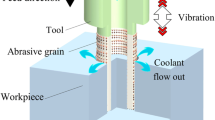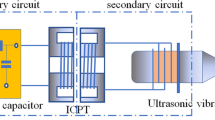Abstract
To improve the capacity and reliability of a rotary ultrasonic machining system, a novel giant magnetostriction ultrasonic processing system (GMUPS) was designed. By using the equivalent circuit model, an optimal compensation model of the GMUPS, with and without a rotary transformer, was proposed. Considering the distributed capacitance of the coil at high frequency, the method of impedance analysis was applied to determine a feasible optimal compensation. To identify the optimal compensation parameters, the characteristics of the GMUPS were studied, including its primary and secondary currents, resonant frequency, and vibration amplitude. The results of the vibration amplitude test demonstrated that impedance analysis was a feasible way to determine the optimal compensation capacitance. The compensation circuit greatly affected the magnitude of the vibration output of the GMUPS, while it did not affect the amplitude-current sensitivity or resonant frequency of the GMUPS. By optimizing the compensation circuit, the impedance of the GMUPS was obviously reduced and the vibration amplitude was maximized. In addition, these results show that impedance analysis can produce a series of relatively optimal compensation capacitances, which makes it greatly useful for adjusting the compensation capacitance as the primary or secondary compensation capacitance deviates from its optimal value.
Similar content being viewed by others
References
Wan Y, Lin B, Wang SL, Cao XY (2014) Study on the system matching of ultrasonic vibration assisted grinding for hard and brittle materials processing. Int J Mach Tools Manuf 77(7):66–73. doi:10.1016/j.ijmachtools.2013.11.003
Wang JJ, Zhang CL, Feng PF, Zhang JF (2016) A model for prediction of subsurface damage in rotary ultrasonic face milling of optical K9 glass. Int J Adv Manuf Technol 83(1):347–355. doi:10.1007/s00170-015-7567-3
Zhang CL, Zhang JF, Feng PF (2013) Mathematical model for cutting force in rotary ultrasonic face milling of brittle materials. Int J Adv Manuf Technol 69(1–4):161–170. doi:10.1007/s00170-013-5004-z
Cong WL, Pei ZJ, Sun X, Zhang CL (2014) Rotary ultrasonic machining of CFRP: a mechanistic predictive model for cutting force. Ultrasonics 54(2):663–675. doi:10.1016/j.ultras.2013.09.005
Cai WC, Feng PF, Zhang JF, Wu ZJ, Yu DW (2016) Effect of temperature on the performance of a giant magnetostrictive ultrasonic transducer. Journal of Vibroengineering 18(2):1307–1318
Weisensel GN, Hansen TT, Hrbek WD (1998) High-power ultrasonic TERFENOL-D transducers enable commercial applications. Proc. SPIE 3326, Smart Structures and Materials 1998: Industrial and Commercial Applications of Smart Structures Technologies, 450. doi:10.1117/12.310660.
Kürschner D, Rathge C (2008) Integrated contactless power transmission systems with high positioning flexibility. Power Electronics and Motion Control Conference, EPE-PEMC 2008. 13th. IEEE: 1696–1703. doi:10.1109/EPEPEMC.2008.4635511
Jeong CS, Sung TI, Lee KH, Hong SG, Park IH (2011) Design of contactless inductive energy transmission systems with large air-gap. Electrical Machines and Systems (ICEMS), 2011 International Conference on. IEEE: 1–4. doi:10.1109/ICEMS.2011.6074002
Bortis D, Kovacevic I, Fässler L, Kolar, JW (2013) Optimization of rotary transformer for high-speed applications. Control and Modeling for Power Electronics (COMPEL), 2013 I.E. 14th Workshop on. IEEE, 2013: 1–6. doi:10.1109/COMPEL.2013.6626458
Kawamura A, Ishioka K, Hirai J (1995) Wireless transmission of power and information through one high frequency resonant AC link inverter for robot manipulator applications. IEEE Trans Ind Appl 32(3):503–508. doi:10.1109/28.502160
Ruviaro M, Runcos F, Sadowski N, Borges IM (2012) Analysis and test results of a brushless doubly fed induction machine with rotary transformer. IEEE Trans Ind Electron 59(6):2670–2677. doi:10.1109/TIE.2011.2165457
Lei W, Jiu-bin T, Shan Z (2010) A giant magnetostrictive actuator based on use of permanent magnet. Int J Adv Manuf Technol 46(9–12):893–897. doi:10.1007/s00170-009-2177-6
Wu J, Dong HJ, Zhang SB, Zhang GY (2009) Novel primary series matching scheme for piezoelectric ultrasonic transducer. Journal of Jilin University (Engineering and Technology Edition) 6(39):1641–1645
Wang CS, Covic GA, Stielau OH (2004) Power transfer capability and bifurcation phenomena of loosely coupled inductive power transfer systems. IEEE Trans Ind Electron 51(1):148–157. doi:10.1109/TIE.2003.822038
Zhu XM, Lin B, Liu LP (2015) Efficiency-based compensations and the mechanical load dependencies of rotary transformer for rotary ultrasonic machining applications. Power Electronics, IET 8(6):986–993. doi:10.1049/iet-pel.2014.0253
Shen H, Feng PF, Zhang JF, Yu DW (2015) Circuit compensation for efficient contactless power transmission in ultrasonic vibration system. Journal of Tsinghua University (Science and Technology) 07:728–733
Wu CH, Tang CC, Liu SI (2003) Analysis of on-chip spiral inductors using the distributed capacitance model. Solid-State Circuits, IEEE Journal of 38(6):1040–1044. doi:10.1109/JSSC.2003.811965
Jiang Z, Excell PS, Hejazi ZM (1997) Calculation of distributed capacitances of spiral resonators. Microwave Theory and Techniques, IEEE Transactions on 45(1):139–142. doi:10.1109/22.552045
Jian HY, Tang ZW, He J, Min H (2005) Analysis and optimum design of differential inductors using distributed capacitance model. Chinese Journal of Semiconductors 26(6):1077–1082
Calkins FT (1997) Design, analysis, and modeling of giant magnetostrictuve transducers, Ph.D. dissertation, Mech. Eng, Iowa State Univ, 1997.
Author information
Authors and Affiliations
Corresponding author
Rights and permissions
About this article
Cite this article
Cai, W., Zhang, J., Feng, P. et al. A bilateral capacitance compensation method for giant magnetostriction ultrasonic processing system. Int J Adv Manuf Technol 90, 2925–2933 (2017). https://doi.org/10.1007/s00170-016-9602-4
Received:
Accepted:
Published:
Issue Date:
DOI: https://doi.org/10.1007/s00170-016-9602-4




